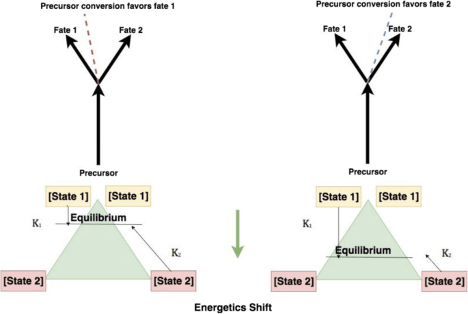Multiomics
Transcriptomics Research
Using metabolomics to gain additional insight from the transcriptome

Used By







Featured Transcriptomics Resources

Metabolomics Complements Transcriptomics
Investigators study gene expression by identifying and measuring RNA transcripts. Transcriptomics reveal the gene expression profile, to show how a cell is responding to intra- and extracellular signals. These data help characterize mechanisms that regulate various physiological and pathophysiological processes. However, not all transcripts are translated into proteins, meaning the transcriptome alone cannot provide a complete picture of cellular and molecular mechanisms.
Metabolomics can significantly enhance transcriptomics research by providing a dynamic view of the functional outputs of gene expression. While transcriptomics focuses on the quantification of RNA transcripts to infer gene activity, metabolomics examines the small molecules produced during metabolic processes, which are direct products of cellular functions. By integrating these two approaches, researchers can correlate changes in gene expression with alterations in metabolic profiles, thereby gaining a deeper understanding of cellular responses and regulatory mechanisms. This synergy allows for the identification of metabolic pathways influenced by specific gene expressions, revealing potential biomarkers and therapeutic targets. Ultimately, the combination of metabolomics and transcriptomics facilitates a more comprehensive view of biological systems, linking genotype to phenotype in a meaningful way.

Gain Additional Insights from the Transcriptome with Metabolomics
Metabolites are the small molecule reactants, intermediates, and products of metabolism that reflect inputs from the transcriptome, proteome, microbiome, and environment. Metabolites also represent the terminal step of the central dogma of biology, making them the closest reflection of a cell, tissue, or organism’s real-time health status. Metabolomics has become recognized as a powerful and complementary tool to transcriptomics, and the value of including it in transcriptomic studies is demonstrated in the case studies discussed below.
Biomarker Discovery and Characterization of Disease Mechanisms
Tuberculosis (TB) affects 1.1 million children annually, resulting in ~200,000 deaths. Although rapid molecular tests are sensitive, their specificity is relatively poor, and they require invasive sample collection. TB induces profound changes to systemic energy and protein metabolism that can be identified in blood, suggesting that blood-based biomarkers may address the current limitations of TB diagnostic tests. To test this hypothesis, one research group performed longitudinal metabolomics and transcriptomics on a large cohort of pediatric TB patients and integrated these datasets for each participant at the time of diagnosis and throughout treatment. They identified three metabolites that correctly identified TB status at diagnosis (AUC = 0.66), and a set of four metabolites that correctly identified TB status one month after treatment (AUC =0.86). Pathway enrichment analyses correlated those metabolites with p53-regulated metabolic genes, mitochondrial translation, and immunoregulatory interactions between lymphoid and non-lymphoid cells. Overall, this study shows that using metabolomics alongside transcriptomics not only identifies novel diagnostic biomarkers, but also reveals mechanistic information that would not have been deduced from transcriptomics alone.
Food Science
Although genetically modified (GM) crops are safe for consumption, introducing genes that confer resistance to insects and herbicides may result in random integration on undesirable genomic regions, leading to low yield, stem splitting, and lower nutritional content. To better understand these potential effects, one research group evaluated the effects of genetic modification on Z58, a commercial strain of maize grown mainly in China. They used global metabolomics and transcriptomics profiling to compare the extent of variation of genetically modified (GM) Z58 to its non-GM strain. To genetically modify Z58 they introduced the HIR gene cassette, which confers insect and herbicide resistance. GM and non-GM crops grown in the same and in different environmental regions of China were compared. Genetic modification increased expression of diacylglycerols, but this difference had little effect on the crops’ phenotype. The most significant differences in transcriptomics and metabolomics were seen between crops grown in different environments. 894 genes were differently expressed based on temperature. Under high temperatures, pathways related to abiotic stress, including arginine/proline metabolism were enriched. By contrast, low temperatures enriched pathways related to membrane injury and production of reactive oxygen species. Altogether, these data showed that the molecular make up of GM Z58 is generally similar to its non-GM counterpart and that differences between the molecular status of each strain of maize was shown to be largely dependent on the environment. This study demonstrates that multiomics analyses are valuable tools for assessing the safety and molecular integrity of GM crops. Future research should continue employing comprehensive omics approaches across diverse ecological regions to ensure the environmental and genetic resilience of GM crops.
Fu W et. al. Evaluation on reprogrammed biological processes in transgenic maize varieties using transcriptomics and metabolomics. Sci Rep. 2021 Jan 21;11(1):2050. PMID: 33479482.
Sports and Exercise Science
A growing body of evidence suggests that contact sports affect neurological health. However, mechanisms that regulate the onset and perpetuation of neurological damage in this context are poorly understood. To better understand this phenomenon one research group used permutation-based mediation statistics to integrate metabolomics, measurements of neuroinflammatory miRNAs, and a virtual reality-based motor control to investigate multi-scale relationships in collegiate football players over one football season. Over 14 mediations (six pre-season and eight across season), metabolites were shown to mediate the statistical relationship between neuroinflammatory miRNAs and virtual reality-based motor control. Further investigation showed these mediating metabolites were consistently medium-to-long chain fatty acids and that tricarboxylic acid cycle metabolites decreased across the season. This led to the hypothesis that repetitive head impacts increases neuroinflammatory miRNAs that prevent the b-oxidation of fatty acids, leading to increased levels of medium-to-long chain fatty acids that cannot be metabolized. This then decreases tricarboxylic acid cycle metabolites, leading to decreased GTP/FADH2/NADH production and subsequent energy crisis that compromises motor control. Altogether, these findings suggest a novel mechanistic framework for injury-induced neurological damage and demonstrate the insight that metabolomics can provide when evaluated alongside transcriptomics in mechanistic studies.
Vike N et. al. A preliminary model of football-related neural stress that integrates metabolomics with transcriptomics and virtual reality. iScience. 2021 Dec 15;25(1):103483. PMID: 35106455




Metabolomics Applications for Transcriptomics Research
- EBiomarker discovery
- EMechanisms of disease onset and progression
- ECharacterizing transcript-metabolite interactions
- ESystems biology
- EGene-metabolite networks
- EEvaluating therapeutic response
- ECharacterizing mechanism of action of novel therapeutics
- EPathway analysis
“By combining metabolomics and transcriptome analysis, one can investigate the levels of metabolites and mRNAs, capitalizing on the disparities and synergies between these two histological studies. This approach enables a comprehensive assessment of gene expression, unveiling novel findings that are not attainable through conventional individual histology.”
Chen, W., Guo, W., Li, Y. et al.
Integrative analysis of metabolomics and transcriptomics to uncover biomarkers in sepsis. Sci Rep 14, 9676 (2024). https://doi.org/10.1038/s41598-024-59400-0
Integrating Metabolomics and Transcriptomics to Analyze Liver Response to Heat Stress in Chickens
In the poultry industry, heat stress is a significant cause of livestock morbidity and low feed efficiency. The liver is an important regulator of metabolism and controls many physiological processes that become compromised by prolonged heat stress. To develop dietary interventions that may mitigate the negative impact of heat stress, one group investigated mechanisms that regulate the heat stress response in the liver of the modern broiler chicken.
Since metabolomics data identifies changes in biologically active compounds and RNA-seq identifies genes that regulate metabolic changes, this research group combined RNA-seq expression and metabolomics profiling of the liver to identify genes and compounds that function as biomolecules associated with heat stress. They developed a statistical pipeline comprised of k-means, random forest and hierarchical clustering. They also applied statistical learning approaches on metabolomic and transcriptomic data to focus their analysis on a core module of liver enriched genes.

Figure 1. Levels of regulating enzymes change as there are changes in gene expression.
Many lipids with a diverse set of signaling and structural roles were prioritized by their statistical approach. Given that the heat stress response involves maintaining the cellular and membrane integrity and saturated and unsaturated fatty acids influence heat shock protein expression, this result aligns with previous findings. Several antioxidants and their precursors including glutathione and cysteinylglycine were also enriched, suggesting an attempt to mitigate cellular damage from toxic intermediates resulting from increased energy production. This was supported by upregulation of sugars and energy-related metabolites. Finally, they identified key metabolites involved in gluconeogenesis, glyceroneogenesis, and amino acid catabolism, suggesting that glycine is shunted towards gluconeogenesis under heat stress and contributes to F6P production. At the same time, amino acids from catabolized proteins fuels the decoupling of gluconeogenesis from glyceroneogenesis under heat stress. With the help of metabolomics, this study revealed novel insight into heat stress regulation that suggests candidates for follow-up feed supplementation studies. Future research can leverage these findings to explore targeted breeding programs or dietary supplements that mitigate the adverse effects of heat stress, aiming to enhance the resilience and productivity of poultry under increasingly variable climate conditions.
Transcriptomics Publications and Citations
Metabolon has contributed extensively to multiomics publications.
Multiomics Knowledge Base
Dive deeper by viewing our case studies and webinars. Learn more about how Metabolon furthers multiomics research.
Contact Us
Talk with an expert
Request a quote for our services, get more information on sample types and handling procedures, request a letter of support, or submit a question about how metabolomics can advance your research.
Corporate Headquarters
617 Davis Drive, Suite 100
Morrisville, NC 27560

